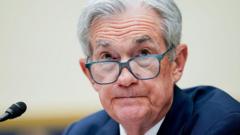As the deadline for Trump's tariffs approaches, businesses are grappling with the financial repercussions and repositioning their supply chains globally. Company leaders express the challenges of transitioning away from Chinese manufacturing amidst rising tariffs while evaluating new markets to mitigate costs.
Tariff Turbulence: Redefining Global Supply Chains Amid Economic Strain

Tariff Turbulence: Redefining Global Supply Chains Amid Economic Strain
The expiration of Trump's tariffs pause threatens to reshape international trade relationships, compelling companies to rethink their supply chains, notably shifting from China to countries like Vietnam and India.
With the 90-day reprieve on Donald Trump's tariffs approaching its conclusion, the looming uncertainty is shaking up US trading dynamics with countries across the globe. The pressure to adapt is prompting businesses to radically reconfigure their supply chains, influenced heavily by heightened import taxes.
Rick Woldenberg, CEO of the Illinois-based educational toy manufacturer Learning Resources, exemplifies the distress felt by many manufacturers. Woldenberg's company, reliant on Chinese production for most of its products, faced a staggering increase in tariff costs—from $2.5 million to over $100 million annually—when the US hiked tariffs on Chinese goods to 145%. He remarked, "This kind of impact on my business is just a little bit hard to wrap my mind around."
Despite a recent reduction of tariffs on Chinese imports to 30%, these costs remain prohibitive, leading Learning Resources to initiate a shift in production to Vietnam and India. These alternatives, while still subject to a 10% tariff, are perceived as more sustainable compared to escalating Chinese rates. However, Woldenberg is cautious, fearing the new factories may struggle to meet demand amid a rush for alternative production sites.
The tariffs not only target American firms but also impact Canadian companies engaged in cross-border trade. Canada continues to face a dual challenge with the imposition of 25% tariffs on its goods and US-reciprocal duties affecting American exports. This bi-directional pressure forces businesses like Cluck Clucks, a Canadian fried chicken chain, to face tough decisions regarding their imports and menu offerings, as tariffs raise operational costs substantially.
The financial strain is widespread, as highlighted by olive oil producers like Spain's Oro del Desierto. The US tariffs, which currently rest at 10%, risk profitability and compel companies to consider redirecting exports to more favorable markets. The implications for end consumers in the US, already stretched by inflated prices, may become even more pronounced as companies begin passing costs down the supply chain.
Experts like Les Brand, CEO of Supply Chain Logistics, stress the challenges associated with shifting suppliers, emphasizing the extensive research and quality testing required to ensure seamless transitions. The process can be time-intensive, diverting focus away from core business activities and affecting profitability.
As businesses acclimate to these challenging economic realities, many await further developments from the US government regarding tariffs. In an environment rife with uncertainty, leaders like Woldenberg recognize they must make informed choices amid unpredictable trade policies, asserting, "I don't want to say 'hope for the best', because I don't believe that hope is a strategy." As companies adapt to these tariff-driven dynamics, the global landscape of supply chains continues to transform.






















